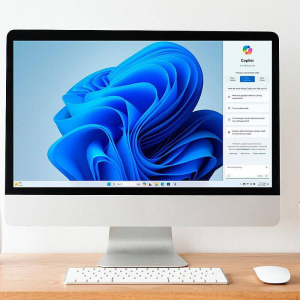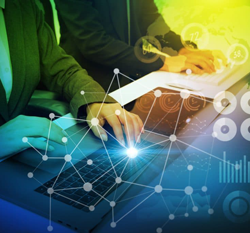CONTACT US
info@bidaiondo.com

From windows to touch screens: the next disruption of the human-machine interface is an unknown

Our way of interacting with technology has changed dramatically, but it may change even more in the coming months and years.
If in 1950 you wanted to communicate with a computer, you used a punch card. In the early 1960s, engineers working in this field realized that this form of interaction was a nightmare, and they ended up discovering that it involved a lot of "talking" to machines through a keyboard and a monitor on which showed that interaction.
This is how the command line interface (CLI) was born, which would end up being fundamental in Unix systems and later in the introduction of personal computing and microcomputers. We were all happy with that – I was happy with my C64 – but we had no idea that in reality it was also quite terrifying and unfriendly.
And then came the Xerox PARC, from which came (among other things) a new concept called graphical user interface (GUI). Those in charge at Xerox did not know what they had in front of them and let the opportunity pass them by. Steve Jobs, no.
The co-founder of Apple saw that this was the future and demonstrated it with the Macintosh of 1984. Microsoft ended up joining the trend, and for more than two decades we believed that everything had already been invented and that there was no better way to interact with a machine than with a mouse and a keyboard.
It was a lie.
In 2007, Steve Jobs showed the world that things could get better. The iPhone and its multi-touch screen were born. We no longer needed a mouse and keyboard to operate that pocket computer. Our fingers were enough. That prodigy experienced its own revolution—goodbye capacitive buttons, hello gestures—and took us to where we are today.
And again we believe that everything has already been invented and that there is no better way to interact with a machine than by planting our fingers on the screen.
Is that a lie?
That is the big unknown, because they have been looking for a replacement for the smartphone for years. The smart watch tried it and the virtual reality glasses tried it, but neither one nor the other have gone beyond being more than mere extensions of the smartphone or the PC, respectively. Without them—at least, in most cases—they lose much of their meaning.
But in 2023 we have glimpsed some ideas that point to a new (and potential) disruption. There are new trends in the ways in which we communicate with machines, and perhaps some of them will end up achieving what seems difficult: making that human-machine interface (HCI) even better. Which are? Let's review them:
Voice: Voice assistants like Google Assistant or Siri tried to become the new way to interact with technology. Despite being an integral part of our mobile phones and also being drivers of IoT and connected devices, their scope has always been limited. Some cite the context problem as a reason: human conversation is full of nuances, and translating them into an HCI system is, for the moment, useless. So we speak with clear orders, almost having to learn the language of the machine so that it understands us.
Augmented reality: Google Glass could have been but it wasn't. Since then we have seen several attempts to turn augmented reality into the next big revolution in technology... without success. Magic Leap promised too much, and for some time now it is Apple that seems to be clear that this is the way. Their Apple Vision Pro are one of the great hopes in this sector, and they are largely so not because of what they do, but because of how they do it.
Eye tracking: The first major pillar of Apple Vision Pro control is its eye tracking system, which allows us to detect where we are looking to interact with that element that is on the screen and not with another. It is an exceptional idea that, yes, seems limited by the fact of having to wear glasses, but it is not alone.
Gestures: The other part of the Apple Vision Pro user interface are gestures with the fingers of the hands, which only need to be visible to the glasses to be detected. The concept is not new—the new Apple Watches also offer partial support for these gestures, and long before we saw how the Nintendo Wii and Microsoft Kinect took advantage of this technology. It does not seem that gestures can change everything, but they could become an interesting element of this new way of interacting with machines.
Wearables: Humane's AI Pin is the latest major player in the wearables sector—in 2023 not even AI will help us with a decent translation of that term—but that doesn't mean it will succeed. The purpose seems to be to replace the traditional mobile phone, but those who have seen it in action are not at all clear. That mini projector... Anyway.
Chatbots: perhaps the true revolution in human-machine interfaces was one that was before us because it was the one that (almost) started it all. We've already talked about the command line: that was our way of talking to machines, but the GUI arrived and usability won too many integers. Now that concept is back in fashion with ChatGPT and the rest of the text generative AI platforms: these chatbots – there is a company that calls them co-pilots – allow us to talk much more naturally with machines. They understand us and respond to us so well that it almost makes us want to leave the traditional search engines behind to talk to the machines.
Will some of these technologies gain real prominence in the short term? A year ago we would surely have ruled out chatbots - be careful, we are already experiencing a fever for this technology - but the arrival of ChatGPT has changed everything and we seem more willing than ever to chat with our computer or mobile phone. In the latter, by the way, it is even more natural to speak now that the chatbot understands us much better.
https://www.xataka.com/aplicaciones/ventanas-a-pantallas-tactiles-proxima-disrupcion-interfaz-hombre-maquina-incognita
Last news
FITUR apuesta por la IA para revolucionar la atención al público.

Temu lanza su nueva app para Shopify en España: una puerta de entrada a millones de clientes globales.

online trading systems.
 We show you the best way to market products and services online, through a professional service of installation, management and maintenance of your virtual store
We show you the best way to market products and services online, through a professional service of installation, management and maintenance of your virtual store
We program to suit you
 We help you achieve operational excellence in all your business processes, whether they are production, logistics, service or office processes. In addition, we assure you to maintain continuous improvement in your management.
We help you achieve operational excellence in all your business processes, whether they are production, logistics, service or office processes. In addition, we assure you to maintain continuous improvement in your management.
Bidaiondo Articles
Technical SEO vs Content SEO: When to hire an external expert.

In the world of search engine optimization (SEO), not all tasks are created equal, nor do they require the same level of expertise. While we often refer to SEO as a single discipline, it's actually divided into two main areas that complement each other: technical SEO and content SEO. Both are essential for an eCommerce site to achieve organic visibility, but they involve very different skills. This is why many companies wonder when the right...
Christmas marketing ideas to increase engagement… and your sales.

Christmas is the perfect time to enjoy family and friends, savor delicious dishes and sweets you don't get to eat the rest of the year, take that short getaway you've been dreaming of… and, of course, sell. The Christmas campaign is undoubtedly the highlight of the calendar for millions of companies worldwide: a crucial period when a large part of the year's budget is at stake. That's why marketers around the globe dedicate...

ABOUT US
FILES

Welcome to Bidaiondo, dear user
BIDAIONDO SL, as the party responsible for the website www.bidaiondo.com, uses its own operating cookies and those of third parties of an analytical nature to allow the use of the website, analyze our services and show you information related to your preferences based on a profile drawn up from of your browsing habits (for example: pages visited). Please bear in mind that, if you do not activate some types of cookies, such as operational and analytical cookies, your experience of using this website may be affected. You can obtain more information and configure your preferences in the CONFIGURE option that appears below, you can reject cookies in the REJECT AND CLOSE option or accept all cookies and continue browsing in the ACCEPT AND CLOSE option.
So do you want to know more?
Data privacy seems important to you, and it is to us too. We store cookie data for 13 months. If you want to know more, you can visit our pages Privacy Policy y Cookies policy. Do you know what cookies are? Cookies are files that are used by virtually all websites. When browsing our page, they are installed in your browser or device to ensure that the website works correctly and store information about your visit. The data provided by cookies treat the user anonymously and in no case do they store personal information.
The data collected by the cookies we use are:
- Addresses IP
- References of visited pages
- References of downloaded files
- The website itself www.bidaiondo.com
- https://www.moz.com
- https://secure/europeanssl.eu

 Spanish
Spanish













